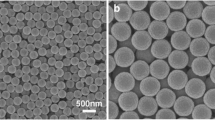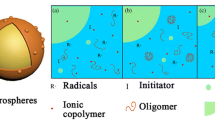Abstract
To study the mechanism and formation of gamma ray–irradiated porous polymeric microspheres, a polymerization reaction was seeded with particles and pores of various sizes. The porous particles were formed via phase separation derived from the modification of an un-grafted polystyrene (PS). The morphology of the porous sulfonated polystyrene/poly(methyl methacrylate) (SPS/PMMA) microspheres was controlled by varying the degree of swelling and the duration of sulfonation. The procedure was initiated by swelling SPS microspheres with MMA, which possessed similar solubility parameters to PS. Water permeated the SPS microspheres via osmosis and produced a sizeable water phase, which formed pores after drying. A sufficient swelling period was required to stabilize the permeated MMA and water. Furthermore, hydrophilic groups within the particles contributed to the degree of water and monomer that was absorbed by the particles. As a result, various micro-sized porous particles were fabricated and pore sizes could be controlled by adjusting the sulfonyl groups.

ᅟ












Similar content being viewed by others
References
Sing KSW, Everett DH, Haul RAW, Moscou L, Pierotti RA, Rouquerol J, Siemieniewska T (1985) Reporting physisorption data for gas/solid systems with special reference to the determination of surface area and porosity. Pure Appl Chem 57:603–619
Everett DH (1972) Manual of symbols and terminology for physicochemical quantities and units, appendix II: definitions, terminology and symbols in colloid and surface chemistry. Pure Appl Chem 31:579–638
Svec F, Frechet JMJ (1996) New designs of macroporous polymers and supports: from separation to biocatalysis. Science 273:205–211
Yang X, Chen L, Huang B, Bai F, Yang X (2009) Synthesis of pH-sensitive hollow polymer microspheres and their application as drug carriers. Polymer 50:3556–3563
Pulko I, Wall J, Krajnc P, Cameron NR (2010) Ultra-high surface area functional porous polymers by emulsion templating and hypercrosslinking: efficient nucleophilic catalyst supports. Chem Eur J 16:2350–2354
Yuan S, Dorney B, White D, Kirklin S, Zapol P, Yu L, Liu D-J (2010) Microporous polyphenylenes with tunable pore size for hydrogen storage. Chem Commun 46:4547–4549
Wood CD, Tan B, Trewin A, Su F, Rosseinsky MJ, Bradshaw D, Sun Y, Zhou L, Cooper AI (2008) Microporous organic polymers for methane storage. Adv Mater 20:1916–1921
Li B, Huang X, Liang L, Tan B (2010) Synthesis of uniform microporous polymer nanoparticles and their applications for hydrogen storage. J Mater Chem 20:7444–7450
Chen M, Wang Z, Han D, Gu F, Guo G (2011) Porous ZnO polygonal nanoflakes: synthesis, use in high-sensitivity NO2 gas sensor, and proposed mechanism of gas sensing. J Phys Chem C 115:12763–12773
Zhang R, Qi L, Xin P, Yang G, Chen Y (2010) Preparation of macroporous monolith with three dimensional bicontinuous skeleton structure by atom transfer radical polymerization for HPLC. Polymer 51:1703–1708
Kimmins SD, Cameron NR (2011) Functional porous polymers by emulsion templating: recent advances. Adv Funct Mater 21:211–225
Wu D, Xu F, Sun B, Fu R, He H, Matyjaszewski K (2012) Design and preparation of porous polymers. Chem Rev 112:3959–4015
Naka Y, Kaetsu I, Yamamoto Y, Hayashi K (1991) Preparation of microspheres by radiation-induced polymerization. I. Mechanism for the formation of monodisperse poly(diethylene glycol dimethacrylate) microspheres. Polym Chem 29(8):1197–1202
Lee H, Ryu J, Kim D, Yoo Y, Lee SU, Sohn D (2013) Preparation of an imogolite/poly(acrylic acid) hybrid gel. J Colloid Interface Sci 406:165–171
Okubo M, Shiozaki M, Tsujihiro M, Tsukuda Y (1991) Preparation of micron-size monodisperse polymer particles by seeded polymerization utilizing the dynamic monomer swelling method. Colloid Polym Sci 269:222–226
Ge X, Wang M, Wang H, Yuan Q, Ge X, Liu H, Tang T (2010) Novel walnut-like multihollow polymer particles: synthesis and morphology control. Langmuir 26:1635–1641
Li H, Wang M, Song L, Ge X (2008) Uniform chitosan hollow microspheres prepared with the sulfonated polystyrene particles templates. Colloid Polym Sci 286:819–825
Odian G (2004) Reactions of polymers. Principles of Polymerization. John Wiley & Sons, 4th Ed., p 762
Yuan Q, Yang L, Wang M, Wang H, Ge X, Ge X (2009) The mechanism of the formation of multihollow polymer spheres through sulfonated polystyrene particles. Langmuir 25:2729–2735
He X, Ge X, Liu H, Wang M, Zhang Z (2005) Synthesis of cagelike polymer microspheres with hollow core/porous shell structures by self-assembly of latex particles at the emulsion droplet interface. Chem Mater 17:5891–5892
Weng H, Huang X, Wang M, Ji X, Ge X (2013) Formation of cagelike sulfonated polystyrene microspheres via swelling-osmosis process and loading of CdS nanoparticles. Langmuir 29(49):15367–15374
Burke J (1984) Solubility parameters: theory and application. The book and paper group annual, the american institute for conservation; Vol. 3
He X, Ge X, Liu H, Wang M, Zhang Z (2006) Cagelike polymer microshperes with hollow core/porous shell structures. Polym Chem 45:933–941
Budd PM, Ghanem BS, Makhseed S, McKeown NB, Msayib KJ, Tattershall CE (2004) Polymers of intrinsic microporosity (PIMs): robust, solution-processable, organic nanoporous materials. Chem Commun 2:230–231
Heuchel M, Fritsch D, Budd PM, McKeown NB, Hofmann D (2008) Atomistic packing model and free volume distribution of a polymer with intrinsic microporosity (PIM-1). J Membr Sci 318(1–2):84–99
Duan G, Zhang C, Li A, Yang X, Lu L, Wang X (2008) Preparation and characterization of mesoporous zirconia made by using a poly(methyl methacrylate) template. Nanoscale Res Lett 3:118–122
Dwyer JL, Zhou M (2011) Polymer characterization by combined chromatography-infrared spectroscopy. Int J Spectrosc 2011:1–13
Becker CM, Biagini AB, Forte MMC, Amico SC, Vargas JVC, Azambuja DS (2012) Sulfonation and characterization of styrene-indene copolymers for the development of proton conducting polymer membranes. Polímeros 22:395–400
El-Salmawi K, Abu Zeid MM, El-Naggar AM, Mamdouh M (1999) Structure–property behavior of gamma-irradiated poly(styrene) and poly(methyl methacrylate) miscible blends. Appl Polym 72:509–520
Acknowledgements
The authors thank the Korea Atomic Energy Research Institute (KAERI) Advanced Radiation Technology Institute (ARTI) for the use of gamma ray irradiation.
Funding
This work was supported by the National Research Foundation of Korea (NRF) (NRF-2015M2B2A9032029).
Author information
Authors and Affiliations
Corresponding authors
Ethics declarations
Conflict of interest
The authors declare that they have no conflict of interest.
Electronic supplementary material
ESM 1
(DOC 295 kb)
Rights and permissions
About this article
Cite this article
Kim, H., Kim, J.R., Paeng, K. et al. Characterization of porous microspheres prepared via γ-ray irradiation. Colloid Polym Sci 296, 2015–2023 (2018). https://doi.org/10.1007/s00396-018-4417-5
Received:
Revised:
Accepted:
Published:
Issue Date:
DOI: https://doi.org/10.1007/s00396-018-4417-5




